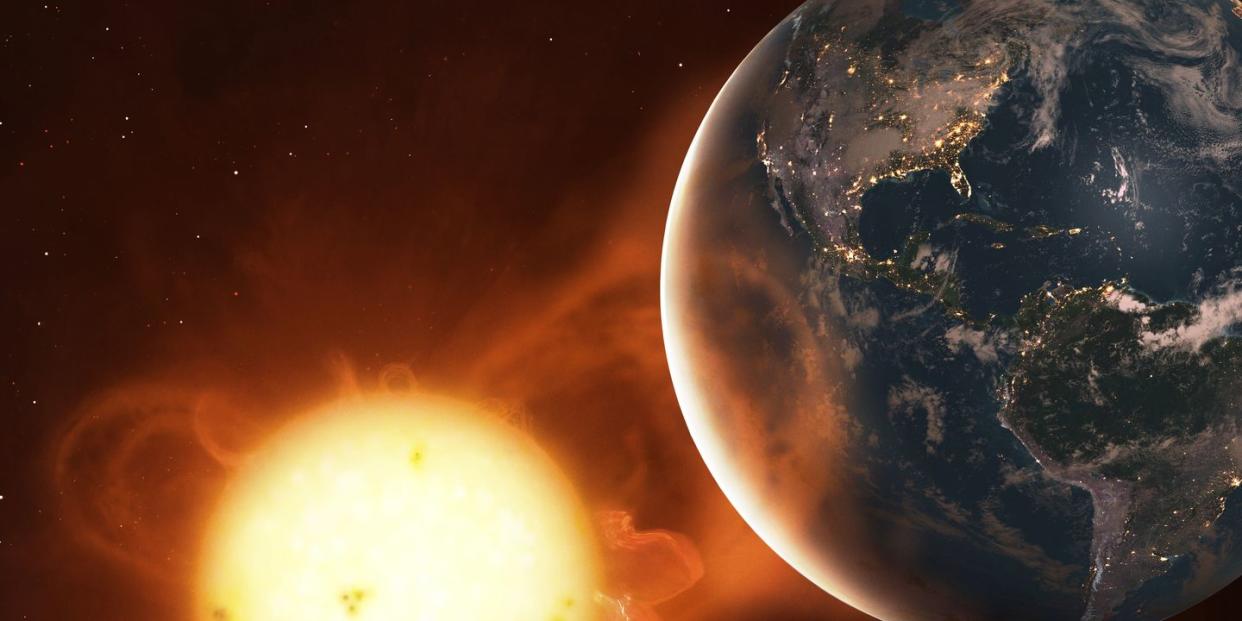Massive Solar Storms Will One Day Wreak Havoc on the Internet

Major solar storms will one day interfere with our internet infrastructure, according to a research paper from a scientist at the University of California, Irvine.
To reduce the risk of a long-term outage, we should place undersea internet cables at lower latitudes where geomagnetic storms could have less impact.
These space storms are considered “black swan” events due to their lack of predictability.
You may be obsessed with checking your local weather radar, but when is the last time you thought about space weather? Turns out, there’s a good reason to tune in: Our sun could cause solar storms that lead to long-term, massive internet outages.
In 2013, insurance company Lloyd’s of London predicted that “the most extreme space weather storms could affect 20-40 million people in the United States and cause up to $2.6 trillion in damages, with recovery taking up to two years,” according to the National Oceanic and Atmospheric Administration.
📡 Science explains the world around us. We’ll help you make sense of it all—join Pop Mech Pro.
Yet, the tech industry has only just begun to consider how to prepare for these solar storms. With so much money at stake, why aren’t more decision-makers paying more attention?
“My dream is to have a [space storm] during the Super Bowl that knocks out the TV broadcast, because then the next day, Congress will approve a lot of money for this kind of research,” Tamas Gombosi, director of the Center for Space Environment Modeling at the University of Michigan, tells Popular Mechanics.
In new research from the University of California, Irvine, scientists zeroed in on some of the potential weak points in our internet infrastructure to help us get ahead.
Disrupting the Grid
Researchers who study space weather are constantly observing solar phenomena and attempting to predict them. There are three main types of events that they focus on: geomagnetic storms, solar energetic particles impacting satellites, and radio bursts associated with flares that can interrupt satellite communications.
Geomagnetic storms, for their part, “start as eruptions in the sun,” Robert Steenburgh, acting lead of the Space Weather Forecast Office at NOAA, tells Popular Mechanics. “The sun will burp out big blobs of plasma into space. The blob carries its own magnetic field with it. And if it’s directed at Earth, if it arrives, it can interact with the Earth’s magnetic field and cause geomagnetic storming. This is probably the most consequential of them.”
Geomagnetic storms disrupt the grid by inducing electric currents on power lines, Steenburgh says. They can also induce currents in cables under the ocean.
“Although the geomagnetic storm is affecting the Earth as a whole, the impacts on the grid are localized based on the geology of the underlying surface underneath those power lines,” Steenburgh explains. “So there are places where that infrastructure’s more susceptible to those induced currents ... It has to do with ground conductivity.”
Satellites can also be affected by “solar energetic protons and heavy nuclei that are ejected during these violent events on the sun,” Steenburgh says. “They can reach Earth in minutes to hours. Spacecraft in orbit can be affected by these particles if they bury themselves in the electronics of the satellites.”
“Black Swan” Events
The U.S. is particularly at risk for web disconnection during solar storms because it’s located at a high latitude and has longer cable infrastructure than Europe, according to the new research. Singapore is a hub of web activity at a safer location near the equator. Asia is relatively resilient; Chinese cities are less safe than Indian ones, though. Australia, New Zealand, and nearby islands will likely lose their long-distance connections. The cable connecting Europe and Brazil is less prone to damage than the ones connecting the United States and Europe.
In the paper, researchers recommend putting undersea cables at lower latitudes. It also supports improving failure testing and modeling, automated responses, data protocols and backup systems.
“We do a lot of failure testing, but most of the testing is for few failures,” Sangeetha Abdu Jyothi, assistant professor of computer science at the University of California, Irvine and author of the paper, tells Popular Mechanics. “Solar superstorms can create a scenario which could cause massive failures. Multiple data centers, multiple links, multiple routers could be down at the same time. We don’t even understand how infrastructure would respond to such a failure scenario. [There are] currently a lot of hand-coded rules for how things should be migrated.”
The COVID-19 pandemic, which Jyothi refers to as a “black swan” event for its unpredictable nature, inspired her to research this topic. “Our society is not taking into account the worst-case scenarios. It was during that lockdown time in April 2020 that I started thinking … I had read about these solar storms a long time back.”
Although some modeling tools for space weather exist, it’s still quite difficult to predict what the sun will do. Steenburgh says that he is excited about the progress scientists are making with digital models, including a new machine learning project.
You Might Also Like
